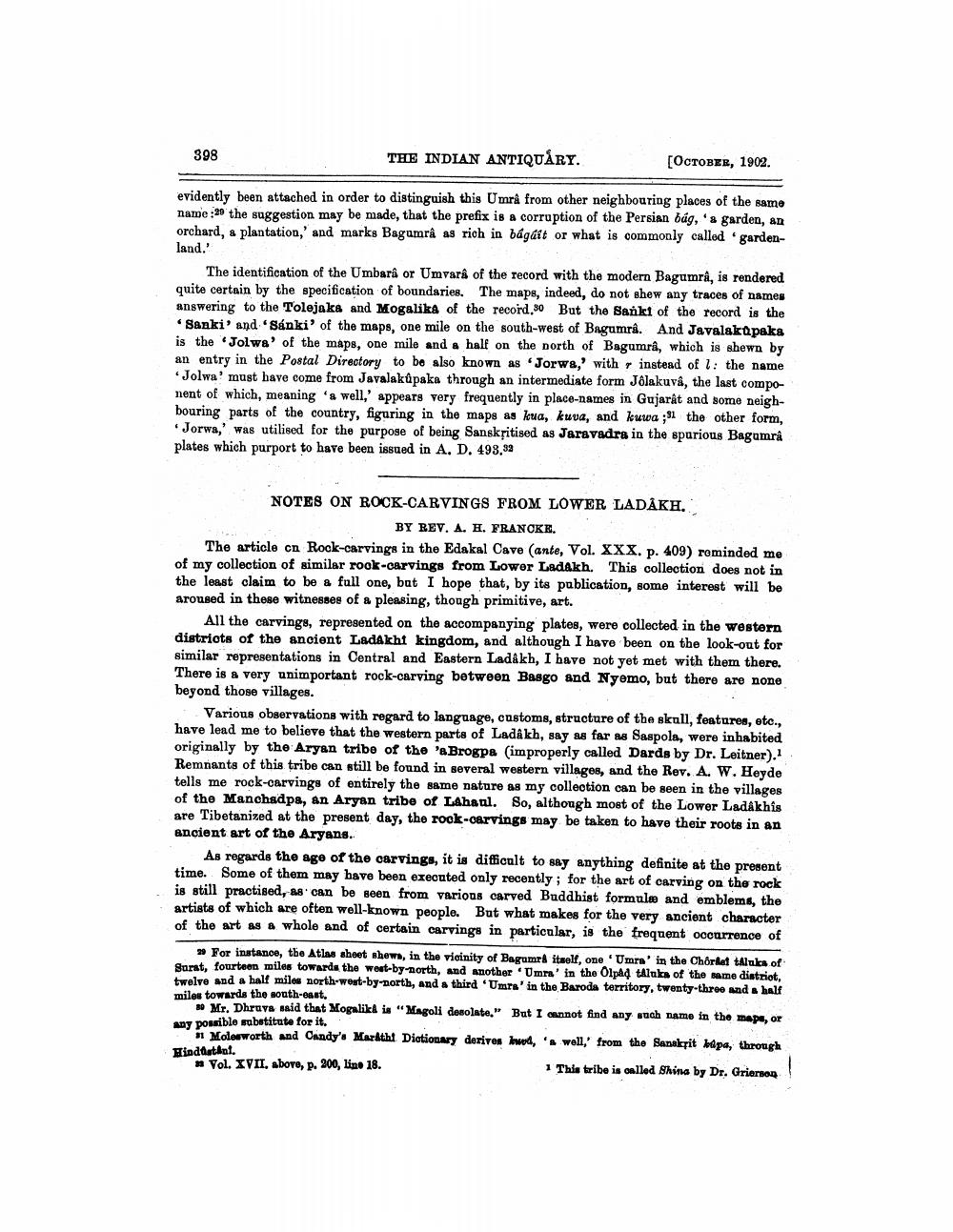________________
398
THE INDIAN ANTIQUÅRY.
[OCTOBER, 1902.
evidently been attached in order to distinguish this Umrå from other neighbouring places of the same name :20 the suggestion may be made, that the prefix is a corruption of the Persian bág,'& garden, an orchard, a plantation, and marks Bagumrå as rich in bágait or what is commonly called gardenland.'
The identification of the Umbarâ or Umvare of the record with the modern Bagumra, is rendered quite certain by the specification of boundaries. The maps, indeed, do not shew any traces of names answering to the Tolejaks and Mogalika of the record.30 But the Bank of the record is the
Sanki' and 'Sánki' of the maps, one mile on the south-west of Bagumra. And Javalakapaka is the 'Jolwa' of the maps, one mile and a half on the north of Bagumra, which is shewn by an entry in the Postal Directory to be also known as Jorwa,' with instead of l: the name
Jolwa' must have come from Javalakúpaka through an intermediate form Jôlakuva, the last component of which, meaning '& well,' appears very frequently in place-names in Gujarat and some neighbouring parts of the country, figuring in the maps as kua, kuva, and kuwa ;$1 the other form,
Jorwa,' was utilised for the purpose of being Sanskritised as Jaravadra in the sparious Bagamra plates which purport to have been issued in A. D. 498.52
NOTES ON ROCK-CARVINGS FROM LOWER LADAKH.
BY REV. A. H. FRANCKE. The article on Rock-carvings in the Edakal Cave (ante, Vol. XXX. p. 409) rominded me of my collection of similar rook-carvings from Lower Ladakh. This collection does not in the least claim to be a fall one, but I hope that, by its publication, some interest will be aroused in these witnesses of a pleasing, though primitive, art.
All the carvings, represented on the accompanying plates, were collected in the western distriots of the ancient Ladakht kingdom, and although I have been on the look out for similar representations in Central and Eastern LadAkh, I have not yet met with them there. There is a very unimportant rock-carving between Basgo and Nyemo, but there are none beyond those villages.
Various observations with regard to language, customs, structure of the skull, features, etc., have lead me to believe that the western parts of Ladakh, say as far as Saspola, were inhabited originally by the Aryan tribe of the 'a Brogps (improperly called Dards by Dr. Leitner). Remnants of this tribe can still be found in several western villages, and the Rev. A. W. Heyde tells me rock-carvings of entirely the same nature as my collection can be seen in the villages of the Manchsdpa, an Aryan tribe of Lahaal. So, although most of the Lower LadAkhis are Tibetanized at the present day, the rock-carvings may be taken to have their roots in an ancient art of the Aryans.
As regards the age of the carvings, it is difficult to say anything definite at the present time. Some of them may have been executed only recently; for the art of carving on the rock is still practised, as can be seen from various carved Buddhist formulæ and emblems, the artists of which are often well-known people. But what makes for the very ancient character of the art as a whole and of certain carvings in particular, is the frequent occurrence of
>> For instance, the Atlos sheet shewa, in the vicinity of Bagumri itself, one 'Umra' in the Chorfet Aluks of Sarat, fourteon miles towards the west-by-north, and another Umra' in the Olpad Aluks of the same distriot, twelve and a half miles north-wont-by-Dorth, and a third 'Umra' in the Baroda territory, twenty-throo and a half miles towards the south-east.
80 Mr. Dhruva said that Mogulika i "Magoli desolate." But I cannot find any such name in the mape, or any possible substitute for it.
1 Molosworth and Candy's Marktht Dictionary desires two, well,' from the Sanakşit bapa, through Hindistant. * Vol. XVII, above, p. 200, lino 18.
1 This tribe is called Shina by Dr. Grierson




